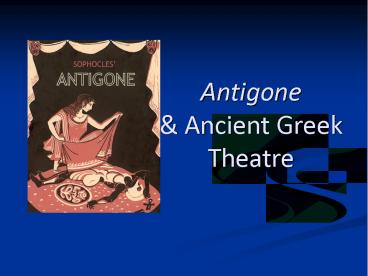Antigone PowerPoint PPT Presentation
Title: Antigone
1
Antigone Ancient Greek Theatre
2
Historical Background
- 700 BCE- Greek culture begins writing
- 534 BCE- The First Tragedy Play Competition
3
Festival Of Dionysus
- The festival was held in the city of Dionysia.
- It lasted for FIVE DAYS and nights.
- Everyone attended.
- All businesses closed.
4
Dionysus
- The festival paid tribute to Dionysus, the god of
wine and fertility. - He was the son of Zeus (ruler of the gods) and
Semele (a mortal woman). To protect his son from
the wrath of Hera (Zeus wife) he took him to
Mount Nysa where the mountain nymphs raised him.
5
THE FIRST TRAGEDY PLAY COMPETITION
- The competition took place over three days,
beginning on the second day of the Festival of
Dionysus. At the time there were only three major
playwrights, so each of them had an entire day to
present their plays. - They each put on THREE TRAGEDIES and ONE SATYR
PLAY. - The prize for winning the festival was a wreath
of ivy.
6
THE FIRST TRAGEDY PLAY COMPETITION continued
- Only men were allowed at the play competition.
- Courts were closed. Prisoners were temporarily
released. - The Greeks considered the plays and essential
part of Greek education.
7
Satyr Plays
- Satyr Plays were crude, satirical versions
(satires) of Greek Tragedies. - They often made fun of heroes or myths.
8
Thespis
- Thespis was the winner of the first tragedy play
contest. - He won when he stepped out from the chorus and
spoke lines by himself. He added to the Greek
tragedy the ideas of a prologue spoken by one
performer and lines being spoken by a character. - He is considered the first actor. That is why
actors are also known as Thespians.
9
Evolution of Greek Theatre
- A second character wasnt added to Greek
tragedies until around 500 BCE- 34 YEARS LATER!!!
10
The Greek Chorus
- Before Thespis, all plays were performed by a
Chorus, or group of men speaking the same
dialogue together at the same time. - The chorus functioned much like a narrator. Often
the chorus would split in half and would say
lines back and forth in a dialogue (conversation)
between two or more characters. - The chorus started as 50 men, but over time it
was reduced to between 12-15.
11
Greek Chorus continued
- The chorus interacted with the characters in the
play, giving commentary or criticizing. - The choragus, or chorus leader, would often speak
as a representative for the entire chorus in
these moments.
12
The Greek Amphitheatre
- The Greek Amphitheatre was built into the side of
a hill.
13
The Greek Amphitheatre
- They held between 15,000 and 20,000 spectators.
- Heres a little perspective our gym holds less
than 2,000 people. - The way they were built made it easier for a
performer to be heard in the back rows. Because
of their brilliance in design, we still use many
of their ideas in building theatres and
performance spaces today.
14
Greek Amphitheatre continued
- The typical Greek amphitheatre contained a
circular Orchestra and a Skene House.
15
Greek Amphitheatre continued
- SKENE HOUSE was a permanent structure built
behind the Orchestra. It had several
doors/doorway which served as entrances/exits. - It was the scenery for the plays. The rooms
inside were used for dressing rooms, offices and
storage.
16
Greek Play Characteristics
- Greek plays usually begin with a prologue- a
scene that introduces the conflict of the play.
This was often spoken by a character directly to
the audience. - The prologue is followed by the parados- the
entrance of the chorus. - The play ended with the exodus- the final scene.
17
Greek Play Characteristics continued
- Because the action in the play moves so quickly,
offstage action is very important in Greek
tragedies. - THE GREEKS MADE NO ATTEMPT TO PORTRAY VIOLENCE
ONSTAGE, even though it was almost always
essential to the story. - A messenger would be used to share important news
of what has happened elsewhere.
18
Greek Masks
- Greek performers also wore elaborate masks with
exaggerated expressions. - They helped them show emotions and with
projecting their voices to the back of the
amphitheatre. - Without masks, audience members in the back would
have a more difficult time understanding the play.
19
Greek Masks
20
Protagonist Antagonist
- The main character in a literary work is called
the protagonist. - This character, who is at the center of the
action, is the one with whom the audience most
sympathizes. - In contrast, the character who is in conflict
with the protagonist is the antagonist.
21
(No Transcript)

